Solana’s promise is to enable anyone with an internet connection to participate in the capital markets.
Original title: "Solana Fndn 2025 Marketing Memo"
Written by: akshaybd
Compiled by: zhouzhou, BlockBeats
Editor's Note: Solana has performed very well in this cycle, with intense on-chain meme transactions and rising token prices. This is due to the Solana Foundation's focus on improving infrastructure performance and reducing latency to meet market demand and drive the growth of founders, applications, and tokenized projects.
The following is the original content (for easier reading and understanding, the original content has been reorganized):
Internet Capital Market and FAT Protocol Engineering
Solana’s promise is to enable anyone with an internet connection to participate in the capital markets, and today you can join the Internet Capital Markets — a globally accessible ledger that tokenizes entities, currencies, and cultures — simply by downloading a wallet or app and clicking a few buttons.
Why is this important?
It helps us create a world where anyone can own assets anywhere, anytime, as long as they have an internet connection. These assets can be global companies, real estate, commodities, and even cultural expressions. This lays the foundation for "universal basic ownership." The competition for high-performance L1 is not just to build a decentralized Nasdaq, but also to build an Internet-native Nasdaq successor - a capital market with better accessibility, lower latency, and shared global liquidity.
The opportunity is as simple as it is huge: Currently, only about 15% of the world's population can participate in the U.S. capital markets, which are the most liquid in the world. Capital markets in many other countries lack liquidity, are expensive to enter, and have inefficient settlement. Cryptocurrency markets are more accessible and liquid. At their peak, their trading volume even exceeded that of NASDAQ and NYSE. We have the opportunity to build the best capital markets on the Internet.
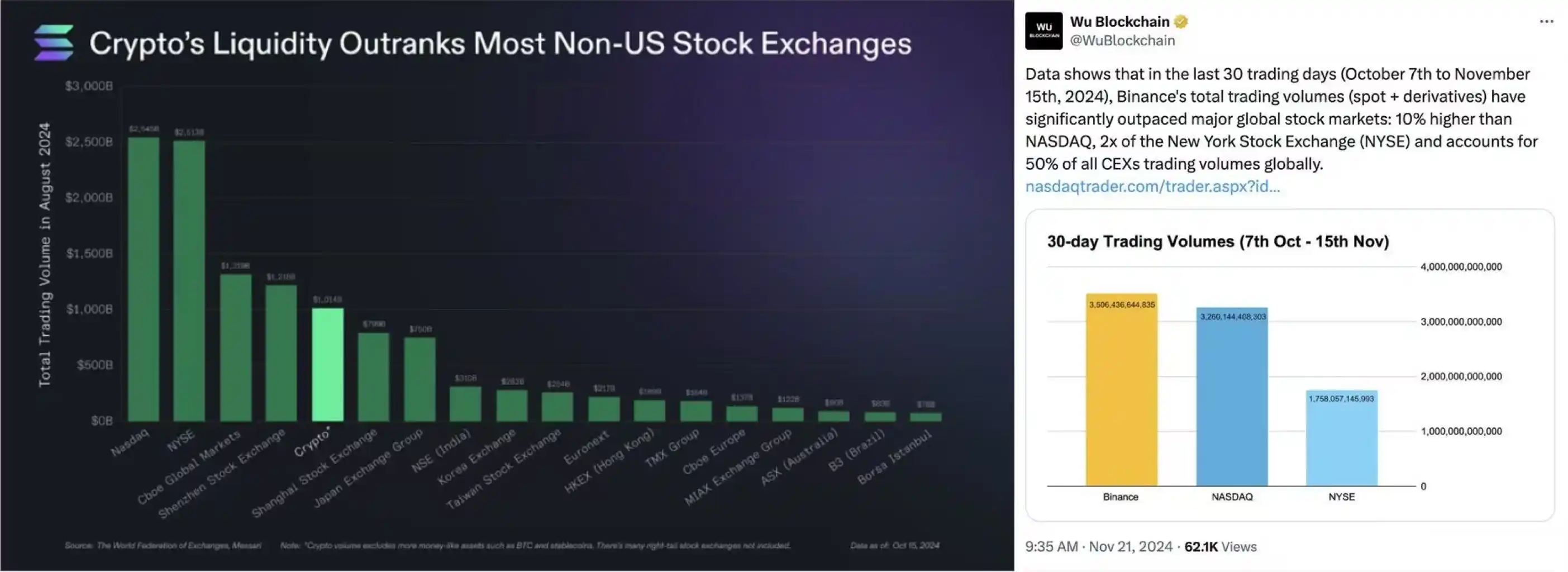
In the future, companies will be listed directly "on the Internet" and will be able to reach more than a billion investors who hold private keys - using their funds to vote for the future they want. Not limited to stocks, but also all valuable asset classes, cultures, and ideas.
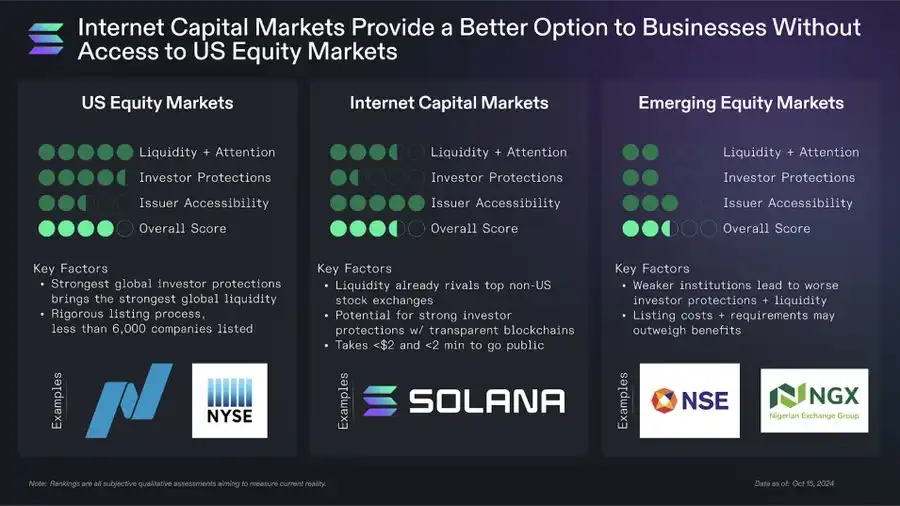
How can we accelerate toward this future?
This is the significance of FAT protocol engineering. In the past, most of this industry was built on the idea that "value will be mainly concentrated in the infrastructure layer" (Fat Protocols, 2016). 8 years later, we are still building infrastructure because it tends to attract higher valuations.
Solana’s ecosystem, by contrast, chose to bet on product, as reflected in its Breakpoint 2024 presentation. By focusing on founders, applications, and tokenization, Solana’s share of the transaction fee market — an excellent indicator of ecosystem activity and overall health — grew 1,489% to 12% in 2024.
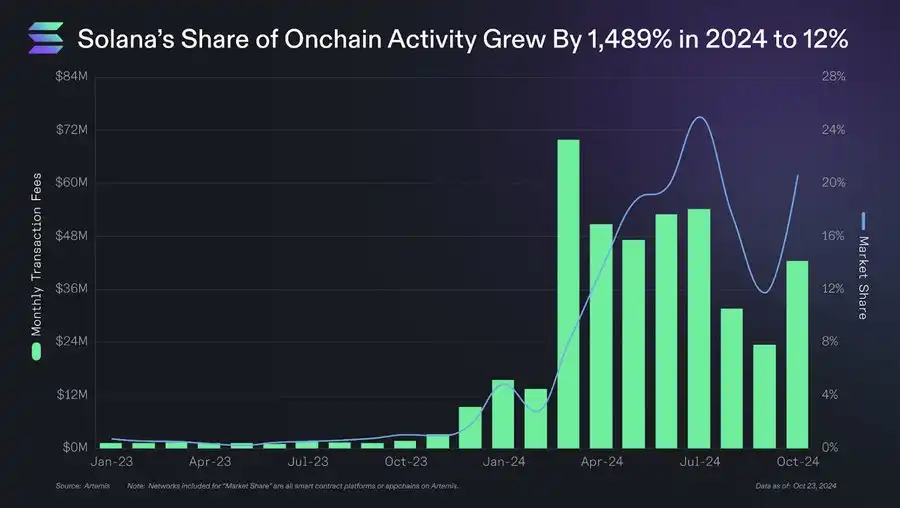
F = Founders, not just developers
Now, it has never been easier or faster for a group of determined founders to go from a garage startup to a billion-dollar company with nothing more than an internet connection.
1.tensor: Two founders from Canada, the company is valued at $445 million
2. pump.fun: A UK team that achieved $155 million in fees in 8 months
3. Birdeye: Headquartered in Vietnam, with 24 million users in 2024
The startup flywheel will continue to run at a high speed in 2025. The Colosseum Hackathon (Solana's hackathon) is the largest talent discovery and talent growth program in the crypto field, and its past participants have received a total of US$650 million in financing.
This flywheel benefits from an ecosystem support built for scale: from superteam hubs, shipyard workspaces, to solanaturbine accelerators, community-led infrastructure further accelerates founders’ growth.

A = Applications, not just infrastructure
Infrastructure represents uncertain optimism, while applications represent certain optimism. What is the result of the Solana ecosystem prioritizing products that users actually need?
In October alone, application revenue reached $73 million, a 185-fold year-over-year increase, now leading all networks. In addition, 74% of funds in the ecosystem flowed to applications (compared to 40% for Ethereum) as founders followed user demand.

Solana has always been guided by the philosophy that it is not TVL that matters, but where the economic activity is gathered. Chain GDP (revenue generated by applications) is the primary metric for measuring the long-term success of a protocol. When the revenue generated by applications exceeds the base layer, it means that the protocol layer has reached product-market fit. If your infrastructure layer is exploitative, applications will leave and build their own chains or migrate to other chains.
Study the Laffer Curve.
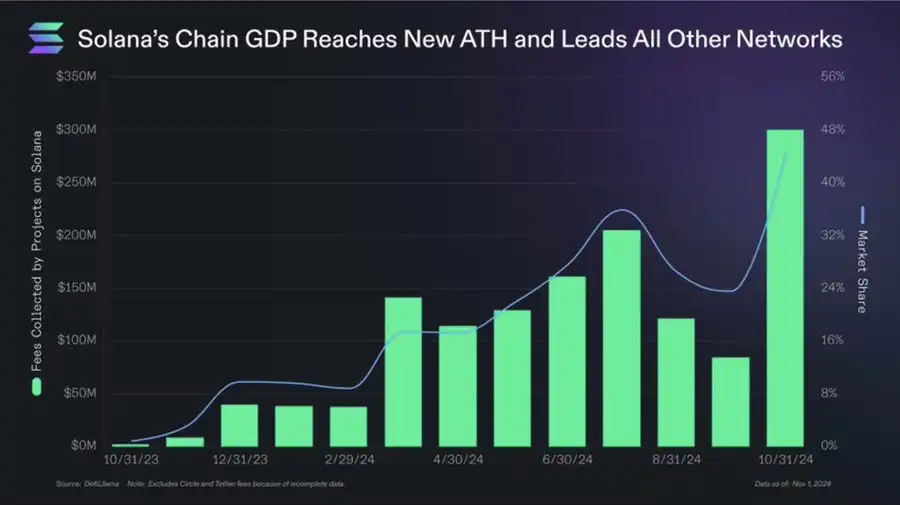
T = Tokenization, not just TVL
TVL is a passive, self-referential metric. Active metrics like capital efficiency, transaction volume, etc. are more instructive. The more important end goal is this: Solana is the best platform for Internet asset launches. In the past 6 months, we have seen 2.6 million tokens launched, representing 78% of all chains. While memes may have a larger share of the public consciousness, they are not the only thing growing.
The treasury balance doubled to $134 million, stablecoins grew 120% to around $4 billion, in addition to 4.2k physical assets from BAXUSco and dvinlabs, 190 million digital collectibles from drip haus, and over 1 million hotspots from helium, to name just a few.
As adoption, tools, and regulation follow, hyper-tokenization will accelerate — a globally accessible ledger where all assets will be tokenized.

Each component of FAT is mutually reinforcing: more founders launch products, more products attract users, more users drive the tokenization of more capital, and more capital attracts more founders. In the third quarter of 2024 alone, the Solana native team raised $178 million.
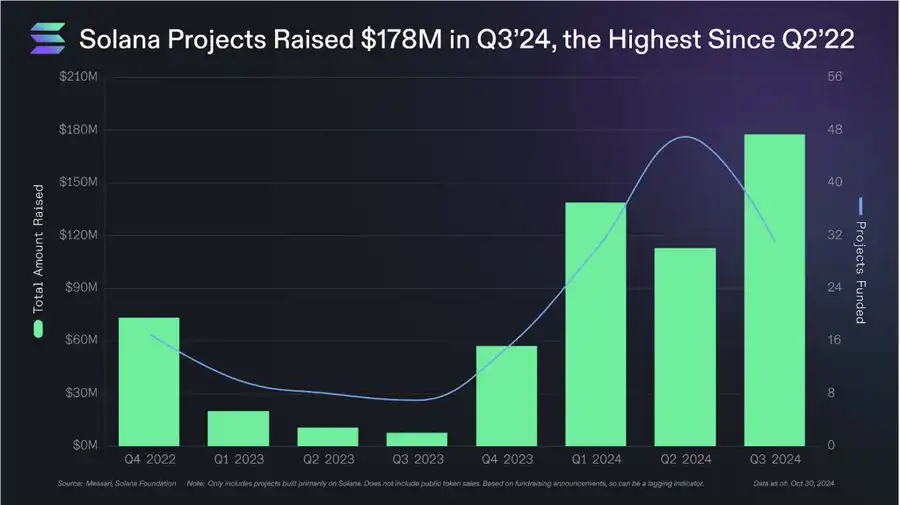
The "Protocol" part of FAT Protocol Engineering
Teams focused on core protocols (such as Anza, Jump, Jito, etc.) work hard every day to improve performance and optimize the experience. They improve Solana's performance and capacity at the base layer by pushing the limits of hardware and software. Improving bandwidth and reducing latency is a key strategy for Solana, emphasizing Solana's continued commitment to building infrastructure for actual use rather than simply for valuation.

Finally, I call it engineering (not theory) because it illustrates an important value inherent in the ecosystem. An opinionated but pragmatic product culture that continually makes hard trade-offs, launches in the real world, and iterates to find product-market fit (PMF). This culture attracts practitioners, not just academics.
As the ecosystem continues to grow, we should maintain this culture and not become dogmatic, or worse — complacent with any temporary success. Cryptocurrency is evolving rapidly and we will always remain flexible and adaptable.
Currently, we anticipate that the Foundation’s marketing activities will support these core pillars through events and content — in the process, we celebrate the best founders, applications, and tokenized projects while teams continue to work hard to improve the speed and performance of Solana. In addition, we will also renew our focus on the US market, as a renaissance of innovation seems to be underway in the US.















